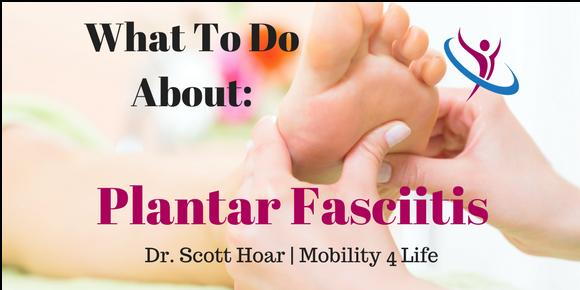
Plantar fasciitis is one of the more common injuries we see in the foot. It's very common with runners, but it's not surprising that this can happen to just about anyone. Typically, it involves very sharp and very painful irritation of the fascia on the bottom of the foot. If it's not addressed in a reasonable time-frame, one can expect bone spurs (bony outgrowth) on the bottom of the heel and increasing irritation.
The Plantar Fascia
The plantar fascia is the distal attachment of the "posterior fascial chain." If you've never heard of fascia before, it is dense connective tissue that can be found throughout the body. If you ever prepared a raw chicken before and had to cut out some of that white, sheet-like tissue that isn't meat, you know what I'm talking about. We have fascial "chains" throughout our body and one of the more neglected ones is what we call the "posterior chain." Think of a rubber band that is stretched from the middle of our back, all the way down to our glutes, our hamstrings, calves, and to the toes on the bottom of our feet. That's the posterior chain. I discuss more about the postural components and what can be done about it in my article "Change Your Posture With One Position."
The plantar fascia is the very bottom portion of the posterior chain. Unfortunately, the entire posterior chain is frequently injured due to our recurrent forward-based posture that really puts our backsides at risk (again see my recent Posture Article). When you add all the foot dysfunction we have because of cushioned shoes and constantly wearing flip-flops from a very young age, you get a recipe for disaster. Here are a few things you can do about it:
Treatment of the Plantar Fascia
In our chiropractic office, we typically will use a combination of Active Release Technique (ART) and Graston Technique. Both of these methods have a great success rate in "releasing" the plantar fascia, and allows any part of the muscle, like scar tissue or adhesion, that might have lost their flexibility or elasticity to soften up again. Typically these are provided by a chiropractor, a physical therapist, and at times a massage therapist. Sometimes the Graston Technique can be a little much for people to handle, so I find people typically respond better to one technique or the other. Here, in these videos, you can see what that's like. Notice how both methods involve treatment to the calves as well as the "posterior chain flexibility," and as mentioned above it needs to be addressed everywhere (i.e. the entire chain), not just where you are in pain.
Hugely important fixations that can be significant causes of plantar fasciitis (that are not addressed in these videos) include:
The 1st Toe into Extension
The 1st Metatarsal-Phalangeal Joint
Calcaneal Eversion
Ankle Dorsiflexion
Most footwear ends up limiting the flexibility in these joints which will add to the stress of the plantar fascia. While some people have great success by using orthotics, others don't. If you're continuing to have significant problems with your foot, please get yourself to a sports chiropractor or manual therapy-based physical therapist that will be able to help you with these foot restrictions.
Kinesiotape for the Popliteus
Kinesiotape can help support the plantar fascia as it's healing. Certain studies point to increased blood flow and healing rates when using Kinesio tape. In contrast, there are also plenty of studies which draw into question the value of certain modalities like Kinesio tape. Personally, I use it in conjunction with other therapies so I'm not concerned if research doesn't always fully support it. If my patient likes it and it makes them feels better, I'll tape it for them.
Self-Release of the Plantar Fascia is Okay
Professional care is.....professional care. Many people will look for remedies without having to go to a professional. If it helps, great. Go for it. It won't always work, but that's okay. If it doesn't, that just points to the fact that there are probably other factors at play that a professional can help with.
Now That It's Released....What's Next?
After increasing the flexibility of the plantar fascia and posterior chain, it's time to "retrain the foot" on how it should actually work. If we forget to perform the upcoming exercises in the rest of this article, we'll just be one of those people that are constantly releasing the plantar fascia, only to have it come back the next day, week, month, year, etc. We need to upload better software, and this is how you do that:
Short Foot Exercise
This is a fantastic exercise originally described by Dr. Vladimir Janda. We are training the intrinsic muscles of the foot to re-attain the arch (and support) of the foot. Be careful not to allow yourself to overly flex your toes while performing this:
Now it's important to note that learning how to perform the "Short Foot Exercise" is not easy and in many cases, you will not be successful at it on your first try. Perform it from a seated position and work on it for 30 seconds or so 2x/day.
Once you get that down we will start to add real movements and exercises while maintaining the "Short Foot" position.
Integration Exercises
By the time you can perform normal exercises while maintaining "Short Foot Position," your foot should be feeling better. Plantar Fasciitis is a condition that should very rarely require a surgical operation. However if you do elect for surgery, just know that after you're done you're going to have to go through this or a similar rehab process as you recover. So why not try this first?
Good luck! Please leave a comment below to let me know if this article is helpful for you or enter your information if you'd like to get a chiropractic exam for your condition.